Posted: December 3rd, 2015 | 5 Comments »
Just how much of this story is true I do not know…but here’s what legend says:
Li Feng (Fen) Shan, “Tiny”, was born in a village in Shantung province (Shandong)
In about 1922 or thereabouts he suddenly started growing, a lot, and got to be nearly eight feet tall and strong with it at 350 pounds – doctors who later examined him said it was due to a glandular issue.
He got a job as the Keeper of the Temple Gate at a temple in a village close by the Hoang Ho (Yellow) River in Shantung. However there were a lot of bandits around that area in the 1920s always looking to loot the temple and they threatened his life. Tiny lit out for Shanghai.
In Shanghai he got a job with the Shanghai Municipal Police and was apparently quite an effective force breaking up riots. He also escorted wages vans to various factories and when potential robbers saw the size of him they invariably back off.
He then decided to quit the SMP in 1930 when he was offered a job with an Australian circus. He sailed to Sydney via Yokohama and joined a travelling circus where he was exhibited wearing the temple gowns with filigree and satins he’d worn in Shantung. He will billed as “The Giant of China”.
And that’s all I know…..
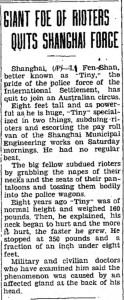
Posted: December 3rd, 2015 | No Comments »
Phyllis Teo’s Rewriting Modernism deals with three modernist women artists in 20th century China….
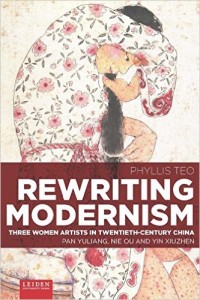
This study offers a fresh, alternative reading of modernism from the perspective of three women artists – Pan Yuliang, Nie Ou and Yin Xiuzhen – who were professionally active at different political stages of twentieth-century China. Through empirical micro- and macrohistories, the research undertaken investigates the ways in which these women have negotiated their identities in circumstances that have made their positions distinct, that is, being women artists as well as living in modern China. Providing relevant narratives and historical events, this book seeks to understand how the conventional perception of gender in Chinese society can be shown to be at work in the visual arts. Its juxtaposition of artists of different generations thus constitutes a deliberate attempt to create new opportunities for comparative studies of female artists in China, and to produce a dynamic reading of modern Chinese art from a different perspective.
Phyllis Teo is an art historian and writer based in Singapore. She lectures, publishes and writes reviews on contemporary art, Chinese art and Asian visual culture. She received her PhD in Culture and Art History from the University of Queensland.
Posted: December 2nd, 2015 | No Comments »
In the history of China and cinema you don’t read much about Norman Westwood. However, he was a pioneer in some respects, showing American moving pictures in the country from around the time of the First World War. He was the manager of Universal Pictures Corporation for many years (17 in all), based in Shanghai at 217 Szechuen Road (PO Box 565 for the train spotters! – now Sichuan Middle Road), and then ran United Artists office in China. Universal was a big operation to oversee in China – as well as their Shanghai offices they had a branch in the French Concession of Tientsin (run by a Mr K.E. Way from offices at 12 Rue Laville – which doesn’t appear on my list of old Tianjin street names I’m afraid) and several others around the country as well as a branch office the King’s Theatre Building in Hong Kong (below).
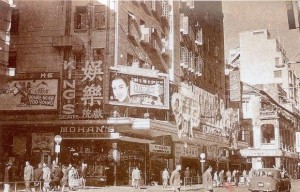
Westwood’s business was really distributing movies around China’s growing number of cinemas and other venues showing films rather than producing his own fare but he did introduce a lot of American cinema to early Chinese audiences and was a pioneer in film distribution. Westwood would try to get exclusive contracts for Universal films with cinemas – a report of a trip to Peking in 1922 reports that he did indeed achieve this aim with a number of Peking cinemas including the Chen Kwang, Kai-Ming and the Gaiety and also worked closely with the Olympic Cinema in the city (for more on that venue see my e-book Badlands: Decadent Playground of Old Peking). He also secured a deal with the Suzhou Kai-ming Theatre (below).
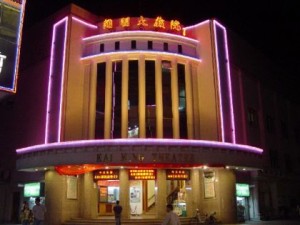 Born in England his family had emigrated to Vancouver from where he came out to Shanghai in 1916 showing Charlie Chaplin two-reelers and early westerns – as you can see from the article below he believed the Chinese liked a lot of action and thrills even as they moved on from Chaplin to Garbo. He returned to North America in 1937 intending to retire in California (though apparently still had a farm up in Canada) but apparently was soon back in Shanghai escorting a delegation of independent film producers, including Republic Pictures.
Born in England his family had emigrated to Vancouver from where he came out to Shanghai in 1916 showing Charlie Chaplin two-reelers and early westerns – as you can see from the article below he believed the Chinese liked a lot of action and thrills even as they moved on from Chaplin to Garbo. He returned to North America in 1937 intending to retire in California (though apparently still had a farm up in Canada) but apparently was soon back in Shanghai escorting a delegation of independent film producers, including Republic Pictures.
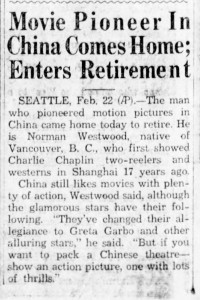
Posted: December 2nd, 2015 | No Comments »
Just a quick plug – I’ve got a piece on the creation and persistence of Asia post-WW2 dynasties in The Diplomat – the piece is anchoring and introducing a series of country-specific pieces…..
click here…you get a bit and then need The Diplomat’s FREE app….

Posted: December 1st, 2015 | No Comments »
An interesting new book on Qing era artistic encounters between China and the West – Qing Encounters….

Qing Encounters: Artistic Exchanges between China and the West examines how the encounters between China and Europe in the eighteenth and early nineteenth centuries transformed the arts on both sides of the East-West divide. The essays in the volume reveal the extent to which images, artifacts, and natural specimens were traded and copied, and how these materials inflected both cultures’ visions of novelty and pleasure, battle and power, and ways of seeing and representing. Artists and craftspeople on both continents borrowed and adapted forms, techniques, and modes of representation, producing deliberate, meaningful, and complex hybrid creations. By considering this reciprocity from both Eastern and Western perspectives, Qing Encounters offers a new and nuanced understanding of this critical period.
Posted: November 30th, 2015 | No Comments »
Welcome news that the Cultural Heritage Council of Macau (CPC) has begun the process to classify two buildings in the central part of the old town as heritage structures. The two buildings (below) are located at the intersection of Rua Central with Calçada de Santo Agostinho and Calçada do Teatro. they are both approximately 130 years old. As well asbeing the oldest on the street they are the only ones to largely retain their original features, though termite damage has been quite severe and a lot of restoration, particularly to the wooden portions and the brick wall beams of the buildings will be required. Good to see that the CPC voted to start and fund the conservation work.

Built in 1848, Rua Central has St. Augustine’s Church located in the middle of the street and has the Chinese name “Long Song”. It was an early site of Portuguese settlement, hence the early European-style buildings, including churches. From the mid-17th century to the late 18th century, prosperous foreign firms and enterprises relocated from Rua dos Mercadores to Nam Van district and Rua Central. Before Avenida de Almeida Ribeiro was built, Rua Central was the transport hub for local residents coming and going between the Inner Harbour and Colina da Penha. the street has changed somewhat over the decades as seen below:

Rua Central c.1920s

c.1950s
 c.1970s
c.1970s
Posted: November 29th, 2015 | No Comments »
I’ll be on a panel this Tuesday (1/12/15) talking about China, World War One and the Chinese Labour Corps…all welcome – click on the below for more details….

Posted: November 28th, 2015 | No Comments »
RASÂ LECTUREÂ Â
Tuesday 1 December 2015
7:00 PM for 7:15 PM start
Radisson Blu Plaza Xingguo Hotel, Tavern Bar
78 XingGuo Road, Shanghai
The Remarkable Story of One of the World’s Most Fascinating Cities
John Darwin van Fleet
Â

John van Fleet presents a breathtaking romp through the city’s Tokyo’s history from the mid 19th to the mid 20th century, with, using lots of images, writings and clippings to bring back to life those far-off days.Â
Â
“A unique, kaleidoscopic and immensely reader-friendly approach to the history of one of the world’s great cities. This book belongs on every Japanophile’s shelf alongside Seidensticker’s High City, Low City.” Mark Schreiber, columnist, Japan Times
“Fire, earthquake, aerial bombardment, fevered construction, fevered reconstruction and re-re-reconstruction have erased and replaced Tokyo many times over. Van Fleet’s Tales retrieves the city from its traces, jolting the reader with Tokyo as it is in the mind’s eye: an explosion of newspaper clippings, police blotters, big character posters, scandal photos, mementos, flags, propaganda, advertisement and scribbled, personal observations – the invisible feast that feeds the spirits of those who have made the city their own.” Michael Thomas Cucek, Adjunct Professor, Sophia University; Temple University Japan Editor-in-Chief, Shisaku
John Van Fleet was raised in Southern California and completed an undergraduate in English and American Literature at the University of Southern California (USC). He moved to Japan in 1991, spending ten years there before relocating to greater China, where he has lived since, first in Taipei and now in Shanghai. While he’s primarily employed as Assistant Dean and Executive Director of the Global Executive MBA in Shanghai (GEMBA), a collaboration between USC and Shanghai Jiao Tong University, he spends his spare time considering the east Asian historical and sociopolitical environment.
Â
An op-ed contributor for the China Economic Review, a reviewer/contributor for the Journal of International Business Education, and a regular reviewer for the Asian Review of Books, Van Fleet is currently working on two new projects – one the story of a tragic couple in Japan in the last decade, the other a collection of essays looking at the interactions of Japan and China, past and present.
Talk Cost: RMB 70.00 (RAS members) and RMB 100.00 (non-members). Includes glass of wine or soft drink. Those unable to make the donation but wishing to attend may contact us for exemption.
Membership applications and membership renewals will be available at this event.
 To RSVP: Please “Reply” to this email or write to
 RAS Bookings at: bookings@royalasiaticsociety.org.cn












